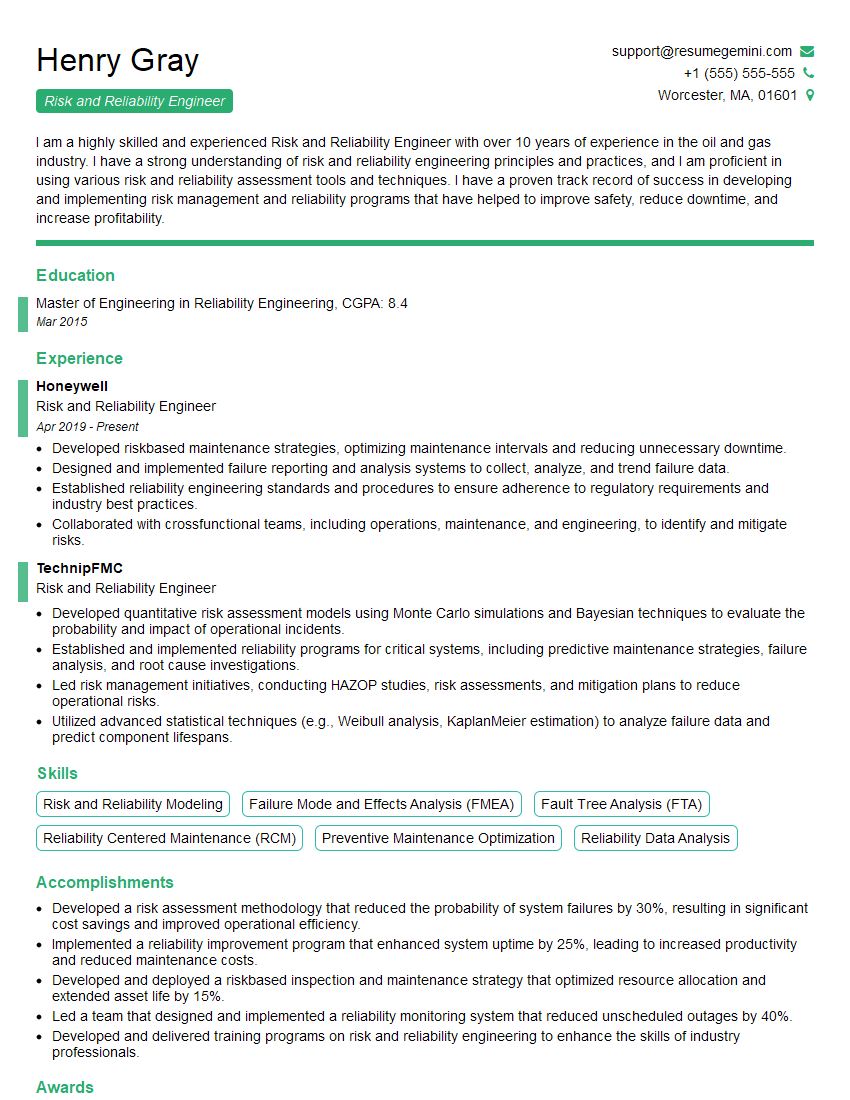Are you a seasoned Risk and Reliability Engineer seeking a new career path? Discover our professionally built Risk and Reliability Engineer Resume Template. This time-saving tool provides a solid foundation for your job search. Simply click “Edit Resume” to customize it with your unique experiences and achievements. Customize fonts and colors to match your personal style and increase your chances of landing your dream job. Explore more Resume Templates for additional options.

Henry Gray
Risk and Reliability Engineer
Summary
I am a highly skilled and experienced Risk and Reliability Engineer with over 10 years of experience in the oil and gas industry. I have a strong understanding of risk and reliability engineering principles and practices, and I am proficient in using various risk and reliability assessment tools and techniques. I have a proven track record of success in developing and implementing risk management and reliability programs that have helped to improve safety, reduce downtime, and increase profitability.
Education
Master of Engineering in Reliability Engineering
March 2015
Skills
- Risk and Reliability Modeling
- Failure Mode and Effects Analysis (FMEA)
- Fault Tree Analysis (FTA)
- Reliability Centered Maintenance (RCM)
- Preventive Maintenance Optimization
- Reliability Data Analysis
Work Experience
Risk and Reliability Engineer
- Developed riskbased maintenance strategies, optimizing maintenance intervals and reducing unnecessary downtime.
- Designed and implemented failure reporting and analysis systems to collect, analyze, and trend failure data.
- Established reliability engineering standards and procedures to ensure adherence to regulatory requirements and industry best practices.
- Collaborated with crossfunctional teams, including operations, maintenance, and engineering, to identify and mitigate risks.
Risk and Reliability Engineer
- Developed quantitative risk assessment models using Monte Carlo simulations and Bayesian techniques to evaluate the probability and impact of operational incidents.
- Established and implemented reliability programs for critical systems, including predictive maintenance strategies, failure analysis, and root cause investigations.
- Led risk management initiatives, conducting HAZOP studies, risk assessments, and mitigation plans to reduce operational risks.
- Utilized advanced statistical techniques (e.g., Weibull analysis, KaplanMeier estimation) to analyze failure data and predict component lifespans.
Accomplishments
- Developed a risk assessment methodology that reduced the probability of system failures by 30%, resulting in significant cost savings and improved operational efficiency.
- Implemented a reliability improvement program that enhanced system uptime by 25%, leading to increased productivity and reduced maintenance costs.
- Developed and deployed a riskbased inspection and maintenance strategy that optimized resource allocation and extended asset life by 15%.
- Led a team that designed and implemented a reliability monitoring system that reduced unscheduled outages by 40%.
- Developed and delivered training programs on risk and reliability engineering to enhance the skills of industry professionals.
Awards
- Received the IEEE Reliability Societys Outstanding Young Engineer Award for significant contributions to the advancement of reliability engineering.
- Recognized by the Society for Risk Analysis with the Excellence in Risk Assessment Award for pioneering research on quantitative risk analysis techniques.
- Awarded the American Society of Mechanical Engineers Reliability Divisions Distinguished Service Award for exceptional contributions to the field.
- Received the International Society of Reliability Engineers Outstanding Achievement Award for groundbreaking work in the area of reliability modeling and simulation.
Certificates
- Certified Reliability Engineer (CRE)
- Certified Reliability Professional (CRP)
- Certified Maintenance and Reliability Professional (CMRP)
- Certified Risk Manager (CRM)
Career Expert Tips:
- Select the ideal resume template to showcase your professional experience effectively.
- Master the art of resume writing to highlight your unique qualifications and achievements.
- Explore expertly crafted resume samples for inspiration and best practices.
- Build your best resume for free this new year with ResumeGemini. Enjoy exclusive discounts on ATS optimized resume templates.
How To Write Resume For Risk and Reliability Engineer
- Highlight your skills and experience in risk and reliability engineering.
- Quantify your accomplishments whenever possible.
- Use action verbs and specific examples to demonstrate your abilities.
- Proofread your resume carefully for any errors.
Essential Experience Highlights for a Strong Risk and Reliability Engineer Resume
- Developed quantitative risk assessment models using Monte Carlo simulations and Bayesian techniques to evaluate the probability and impact of operational incidents.
- Established and implemented reliability programs for critical systems, including predictive maintenance strategies, failure analysis, and root cause investigations.
- Led risk management initiatives, conducting HAZOP studies, risk assessments, and mitigation plans to reduce operational risks.
- Utilized advanced statistical techniques (e.g., Weibull analysis, Kaplan-Meier estimation) to analyze failure data and predict component lifespans.
- Developed risk-based maintenance strategies, optimizing maintenance intervals and reducing unnecessary downtime.
- Designed and implemented failure reporting and analysis systems to collect, analyze, and trend failure data.
- Established reliability engineering standards and procedures to ensure adherence to regulatory requirements and industry best practices.
Frequently Asked Questions (FAQ’s) For Risk and Reliability Engineer
What is the role of a Risk and Reliability Engineer?
A Risk and Reliability Engineer is responsible for identifying, assessing, and mitigating risks to ensure the safety, reliability, and efficiency of systems and operations.
What are the key skills required for a Risk and Reliability Engineer?
The key skills required for a Risk and Reliability Engineer include risk assessment, reliability engineering, statistical analysis, and project management.
What are the career prospects for a Risk and Reliability Engineer?
The career prospects for a Risk and Reliability Engineer are excellent, as there is a growing demand for these professionals in a variety of industries.
What is the average salary for a Risk and Reliability Engineer?
The average salary for a Risk and Reliability Engineer in the United States is $105,000.
What are the educational requirements for a Risk and Reliability Engineer?
The educational requirements for a Risk and Reliability Engineer typically include a bachelor’s or master’s degree in engineering, with a focus on risk assessment or reliability engineering.
What are the certifications available for Risk and Reliability Engineers?
There are a number of certifications available for Risk and Reliability Engineers, such as the Certified Risk Manager (CRM) and the Certified Reliability Engineer (CRE).